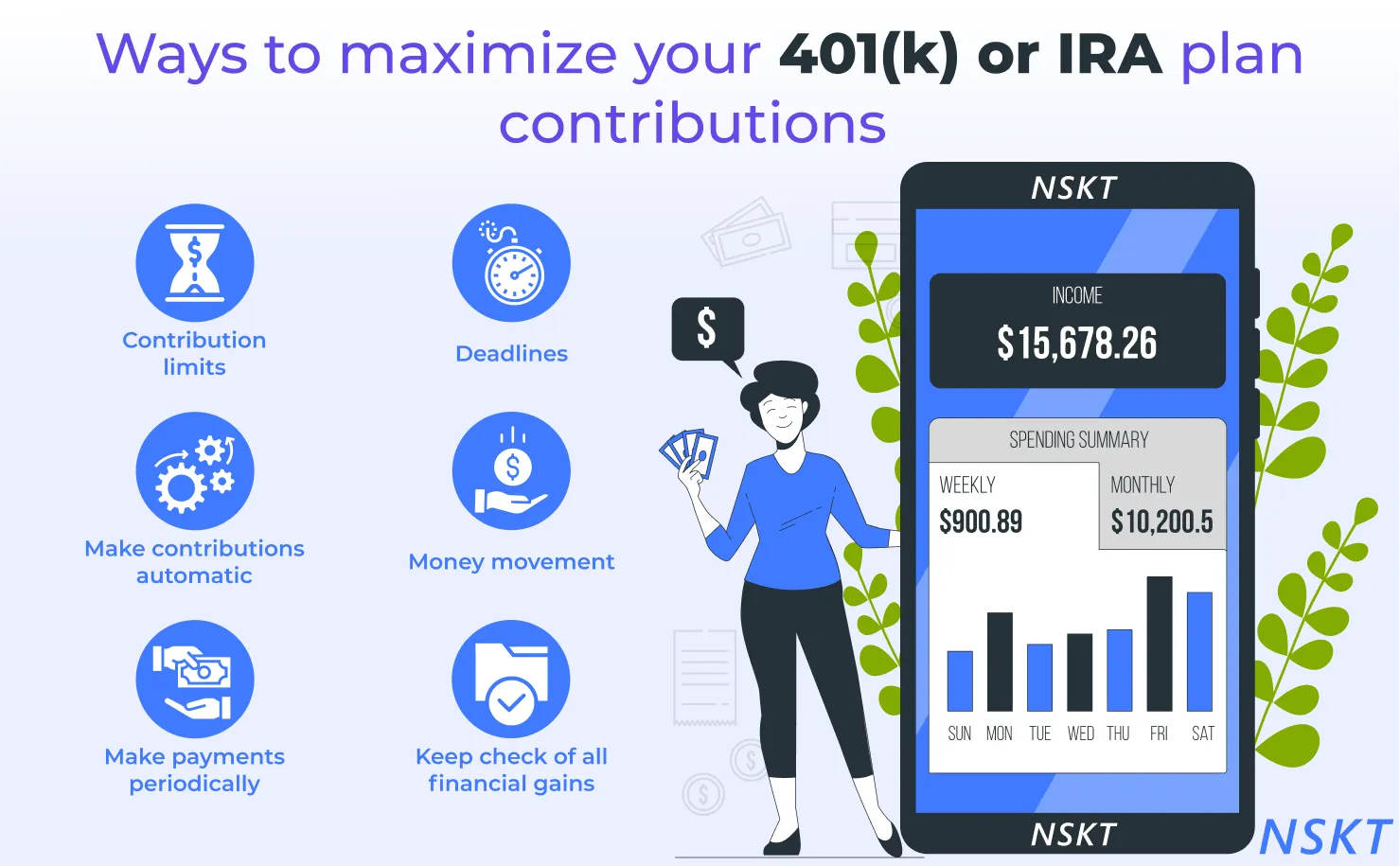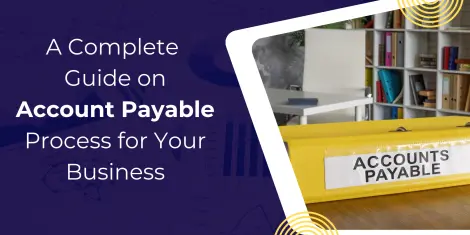Table of Contents
How to Maximize Your 401(k) Balance
Maximizing your 401(k) is one of the smartest financial decisions you can make for a secure retirement. A 401(k) is a retirement savings plan offered by employers, designed to help employees save for their golden years with certain tax advantages. To get the most out of your 401(k), you need a strategic approach, smart planning, and consistent contributions. It requires thoughtful planning, regular reviews, and smart adjustments to keep your retirement savings on track. The earlier you start and the more you optimize your contributions, the larger your 401(k) balance can grow. But it’s not only about contributing more, it'st’s also about making the right investment choices, understanding employer benefits, and avoiding common pitfalls. In this blog we explain how you can make the most of employer matching contributions, explore what happens when you hit the contribution limit, weigh the pros and cons of maxing out your 401(k), and discuss when it’s time to seek professional financial advice.
Steps to Maximize Your 401(k) Plan
Maximizing your 401(k) requires more than just setting up automatic contributions. It involves a series of deliberate actions and informed decisions that help you get the most out of your plan. Here’s a closer look at the strategies you can use:
Step 1. Start Contributing Early
The earlier you begin contributing to your 401(k), the longer your money has to grow through the power of compound interest. Starting early, even with smaller contributions, allows your investments to accumulate and grow over time. This long-term growth can be a significant advantage, especially if you maintain consistent contributions throughout your career.
Step 2. Increase Your Contribution Rate Annually
Rather than sticking with the default contribution rate set by your employer, aim to increase your contributions incrementally each year. Small, regular increases—such as boosting your contribution rate by 1% annually—can substantially improve your retirement savings without making a big impact on your take-home pay.
Step 3. Max Out Employer Matching
Employer matching is essentially free money added to your retirement savings. To get the full benefit, contribute at least enough to receive the maximum match offered by your employer. If you don’t, you’re leaving potential savings on the table.
Step 4. Choose Low-Cost, Diversified Investment Options
The investment options within your 401(k) can significantly impact your returns. Opt for low-cost funds, like index funds or ETFs, which offer broad market exposure and lower fees. Diversifying your investments helps spread risk and can provide more stable growth over time.
Step 5. Rebalance Your Portfolio Regularly
Regular rebalancing of your portfolio helps maintain your desired asset allocation. Over time, market movements can cause your investments to drift from your original plan. By rebalancing, you realign your investments according to your risk tolerance and financial goals.
Step 6. Utilize Catch-Up Contributions if You’re 50 or Older
If you’re 50 or older, the IRS allows you to make additional catch-up contributions to your 401(k). This provision lets you save beyond the standard annual limit, providing an opportunity to boost your retirement savings as you get closer to retirement age.
Step 7. Take Advantage of Automatic Increases
Many 401(k) plans offer features that automatically increase your contribution rate over time. By opting into these automatic increases, you can steadily grow your contributions without needing to remember to make adjustments manually.
Step 8. Avoid Early Withdrawals
Taking money out of your 401(k) before age 59½ can result in sig nificant taxes and penalties. It also reduces your potential future earnings. Keep your funds invested as long as possible to maximize the growth of your retirement savings.
How to Take Advantage of Employer Matching Contributions
Employer matching is one of the best benefits of a 401(k) plan, yet many employees fail to take full advantage of it. Employer contributions can significantly increase your retirement savings, often without any additional effort on your part. Here’s how you can maximize this benefit:
- Understand the Employer’s Matching Formula: Every company has a unique policy regarding matching contributions. Typically, employers match a certain percentage of your contributions up to a specific limit. For example, an employer might match 100% of your contributions up to 5% of your salary. Familiarize yourself with your plan’s matching formula to ensure you’re making the most of it.
- Always Contribute Enough to Get the Full Match: At the very least, contribute enough to receive the full employer match. Failing to do so means you’re missing out on additional retirement funds. Think of the match as part of your overall compensation package.
- Stay on Top of Vesting Schedules: Some employer contributions are subject to a vesting schedule, meaning they become fully yours only after you’ve worked for the company for a certain period. Be aware of these schedules to avoid losing matched contributions if you leave the company too soon.
- Consider the Match in Your Overall Savings Strategy: Don’t underestimate the impact of employer matching on your overall retirement plan. It’s a powerful tool for accelerating your savings and should be a key factor in your financial planning.
What Happens After Maxing Out Your 401(k)?
Hitting the annual contribution limit for your 401(k) is a significant milestone, but it doesn’t mean you should stop saving for retirement. If you’ve reached the limit, here are some additional strategies to keep your savings on track:
- Open an IRA for Additional Savings: An Individual Retirement Account (IRA) offers another tax-advantaged way to save for retirement. You can choose between a Traditional IRA (tax-deductible contributions) or a Roth IRA (tax-free withdrawals), depending on your income and tax situation.
- Invest in a Health Savings Account (HSA): An HSA is a great tool for long-term savings, especially if you have a high-deductible health plan. Contributions are tax-deductible, and withdrawals for qualified medical expenses are tax-free, providing a dual benefit.
- Consider After-Tax Contributions: Some employers allow after-tax 401(k) contributions, which can be a useful option if you want to continue saving within your 401(k) plan beyond the pre-tax contribution limits.
- Explore Taxable Investment Accounts: A taxable brokerage account offers flexibility and a wide range of investment options. It’s a good way to continue building wealth outside of tax-advantaged retirement accounts.
Pros and Cons of Maxing Out Your 401(k) Balance
Before maxing out your 401(k), it’s essential to weigh the benefits against potential downsides. Here’s what you need to know:
Pros:
- Tax Benefits: Pre-tax contributions lower your taxable income, helping you save on taxes while boosting your retirement fund.
- Compound Growth: The more you contribute, the greater the potential for compound interest to grow your savings over time.
- Employer Match Opportunities: Higher contributions may increase the amount your employer matches, providing an additional boost to your savings.
Cons:
- Limited Access to Funds: Withdrawing from your 401(k) before age 59½ typically incurs penalties and taxes, making the funds less accessible for immediate needs.
- Potential for Higher Taxes in Retirement: Traditional 401(k) withdrawals are taxed as ordinary income, which could be a disadvantage if you’re in a higher tax bracket during retirement.
- Lack of Diversification: Relying too heavily on your 401(k) may result in overexposure to employer stock or limited investment options.
Seek Professional Financial Advice
Maximizing your 401(k) requires a well-thought-out strategy tailored to your personal financial situation. A financial advisor can help you create a plan that aligns with your goals, risk tolerance, and tax considerations. They can provide insights on:
- Optimizing Contributions: Advising on whether to prioritize a traditional or Roth 401(k) based on your tax situation.
- Comprehensive Financial Planning: Integrating your 401(k) with other retirement accounts, investment strategies, and insurance needs.
- Adjusting Your Plan as Needed: Providing guidance on when to rebalance, increase contributions, or explore alternative investment options.
Conclusion
Maximizing your 401(k) is a critical step in securing a robust financial future. By implementing strategies such as early contributions, taking full advantage of employer matching, choosing diversified investments, and regularly reviewing your portfolio, you can significantly enhance your retirement savings. While the journey to retirement planning can seem complex, with the right approach and potentially professional guidance, you can build a substantial nest egg that provides financial security and peace of mind. NSKT Global can support this process by offering personalized financial consulting services, helping you develop a comprehensive retirement strategy tailored to your unique financial goals and circumstances.







